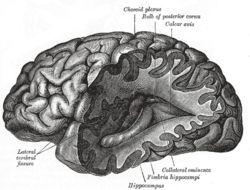Neuropoiesis
Neuropoiesis is the process by which neural stem cells differentiate to form mature neurons, astrocytes, and oligodendrocytes in the adult mammal. This process is also referred to as adult neurogenesis.
History
While rapid neurogenesis was known to occur in the early stages of life, the production and differentiation of neural stem cells was believed to cease upon maturity. This belief was overturned in the 1960s by the work of Joseph Altman.[1] Using injections of thymidine-H3 to label the nuclei of dividing cells, Altman was able to use autoradiography to determine a neuronal birthdate for each cell in a rat's brain. This research revealed some degree of adult neurogenesis in the hippocampus and olfactory bulb of rats, and paved the way for the possibility of neuropoiesis in the adult mammalian brain.
Following Altman's work, thymidine-H3 injections were used to examine the brains of a variety of other species. In the late 1970s Steven Goldman used this technique to examine the vocal control centers of songbirds, and he found widespread evidence of adult neurogenesis in this area of a canary's brain.[2][3] Subsequent studies by Goldman and others revealed the precise mechanisms for neuronal cell differentiation and migration in adult songbirds, and, along with studies done in fish and other species, laid the groundwork for the study of neuropoiesis in humans.[3]
Neuropoietic areas in the human brain
The most recognized initial sites of neuropoiesis ending with neurons in adults are the subventricular zone (SVZ), the thin layer of cells just beneath the surface of the lateral ventricles of the brain, and the dentate gyrus of the hippocampus. Neural precursor cells in the human SVZ are known to yield offspring which can then produce glial cells or even migrate and form new neurons in specific areas such as the mammalian olfactory bulb.[3][4]
Mechanisms of neuropoiesis
Although the exact chemical signaling pathways which regulate Neuropoiesis are still poorly understood, there have been some recent advances in this field. Hematopoiesis, the differentiation of stem cells in the bone marrow to form blood cells, is a comparatively well studied phenomenon, and the study of hematopoiesis has yielded some insight into the mechanisms of neuropoiesis.[5][6] Several developmental genes (e.g. Notch, Delta, neurogenin, neuregulin, OCT, Presenilin) growth factors (e.g. epidermal growth factor, NGF, brain-derived neurotrophic factor), and extracellular matrix proteins (e.g. tenascin, CD34) have been linked to the mechanisms of neuropoiesis.[5][6][7] Many of these factors were originally identified as involved in hematopoiesis, but have since been found in neuropoetic cells in the SVZ.[5][6][8][9]
Research applications
While a full understanding of neuropoiesis is still some time away, there are numerous applications for this research. A complete understanding of the mechanisms for neural differentiation and proliferation could prove to be crucial to the treatment of neurodegenerative diseases. Towards this end, many researchers are attempting to control the differentiation and proliferation of neural stem cells in vivo by altering the expression of key genes such as presenilins and the sonic hedgehog pathway.[8][9][10][11]
References
- ↑ Joseph, Altman; Das, GD (1965). "Autoradiographic and Histological Evidence of Postnatal Hippocampal Neurogenesis in Rats". Journal of Comparative Neurobiology. 124 (3): 319–35. doi:10.1002/cne.901240303. PMID 5861717.
- ↑ Goldman, Steven; F Nottebohm (1983). "Neuronal production, migration, and differentiation in a vocal control nucleus of the adult female canary brain". Proceedings of the National Academy of Sciences. 80 (8): 2390–2394. doi:10.1073/pnas.80.8.2390. PMC 393826
 . PMID 6572982.
. PMID 6572982. - 1 2 3 Goldman, Steven (1999). "Adult neurogenesis: From canaries to the clinic". Journal of Neurobiology. 36 (2): 267–286. doi:10.1002/(SICI)1097-4695(199808)36:2<267::AID-NEU12>3.0.CO;2-B. PMID 9712309.
- ↑ Scheffler, Bjorn; Noah Walton; Dean Lin; Katrin Goetz; Grigori Enikolopov; Steve Roper; Dennis Steindler (2005). "Phenotypic and functional characterization of adult brain neuropoiesis". PNAS. 102 (26): 9353–9358. doi:10.1073/pnas.0503965102. PMC 1150897
 . PMID 15961540.
. PMID 15961540. - 1 2 3 Scheffler, Bjorn; Meyer Horn; Ingmar Blumcke; Eric Laywell; Debra Coomes; Valery Kukekov; Dennis Steindler (1999). "Marrow-mindedness: a perspective on neuropoiesis". Trends in Neurosciences. 22 (8): 348–357. doi:10.1016/S0166-2236(99)01416-2. PMID 10407420.
- 1 2 3 AV, Terskith; M Easterday; L Li; L Hood; H Kornblum; D Geschwind; I Weissman (2002). "From hematopoiesis to neuropoiesis: evidence of overlapping genetic programs". Journal of Neurochemistry. 81: 81–81. doi:10.1046/j.1471-4159.81.s1.105.x.
- ↑ Theodorou, E; G Dalembert; C Heffelfinger; E White; S Weissman; L Corcoran; M Snyder (2009). "Revert field A high throughput embryonic stem cell screen identifies Oct-2 as a bifunctional regulator of neuronal differentiation". Genes & Development. 23 (5): 575–588. doi:10.1101/gad.1772509.
- 1 2 Wen Shu; Li Hong; Liu Jia (2009). "Epigenetic background of neuronal fate determination". Progress in Neurobiology. 87 (2): 98–117. doi:10.1016/j.pneurobio.2008.10.002. PMID 19007844.
- 1 2 Kim, W Y; J Shen (2008). "Presenilins are required for maintenance of neural stem cells in the developing brain". Molecular Neurodegeneration. 3.
- ↑ Park, I H; R Zhao; A West; A Yabuuchi; H Huo; Ince T; P Lerou; M Lensch; G Daley (2008). "Reprogramming of human somatic cells to pluripotency with defined factors". Nature. 451 (7175): 141–6. doi:10.1038/nature06534. PMID 18157115.
- ↑ Porayette, P; M gallego; M Kaltcheva; R Bowen; S Meethal; C Atwood (2009). "Differential Processing of Amyloid-beta Precursor Protein Directs Human Embryonic Stem Cell Proliferation and Differentiation into Neuronal Precursor Cells". Journal of Biological Chemistry. 284 (35): 23806–23817. doi:10.1074/jbc.M109.026328. PMC 2749153
 . PMID 19542221.
. PMID 19542221.
